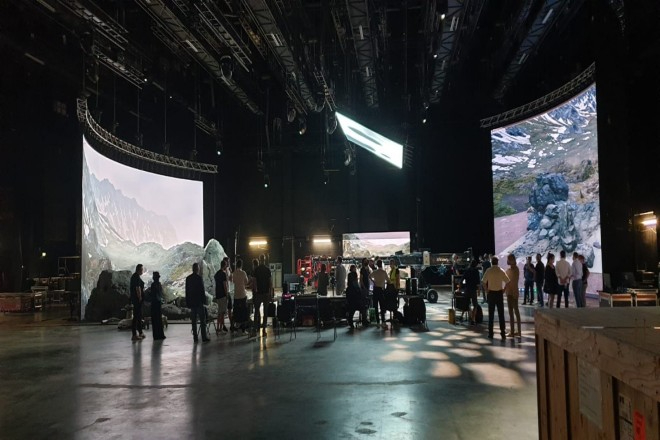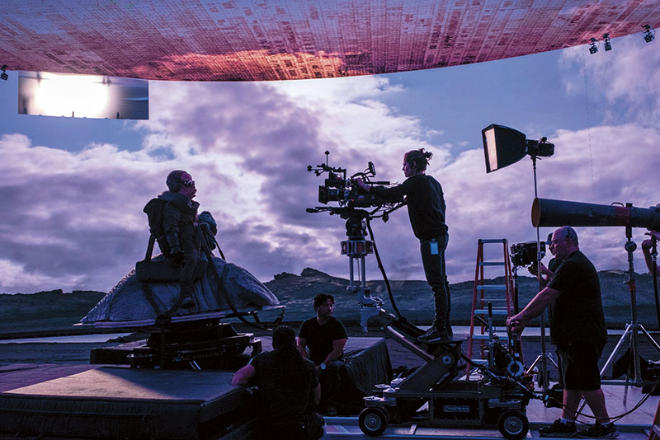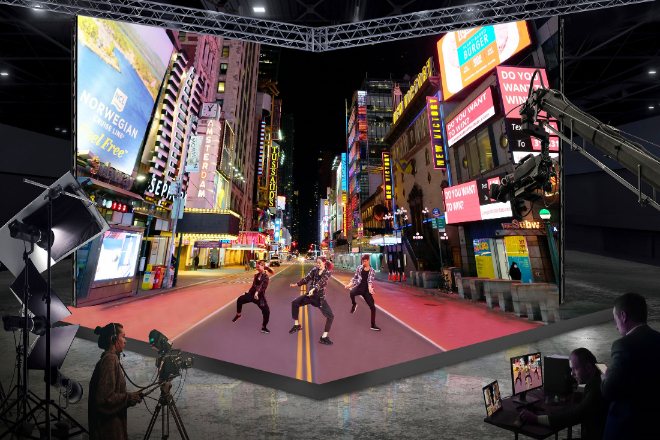Introduction
L’industrie de la production cinématographique et télévisuelle a toujours été confrontée à des défis tels que des cycles de production longs et des coûts élevés.
Avec le développement continu de la technologie, la technologie de production virtuelle de Écrans d'affichage LED est progressivement apparue, apportant de nouvelles solutions pour raccourcir le cycle de production cinématographique et télévisuelle.
Table des matières
1. Une brève introduction à la technologie de production virtuelle des écrans d'affichage LED

La technologie de production virtuelle consiste à utiliser des ordinateurs et des équipements spéciaux pour créer des scènes de film virtuelles.
La technologie de production virtuelle basée sur des écrans d'affichage LED utilise de grands écrans LED pour afficher des scènes virtuelles en temps réel, permettant aux acteurs de jouer comme s'ils étaient dans un environnement réel, et la caméra capture directement cette image synthétique.
L'écran LED fonctionne avec la caméra, le serveur de rendu et le système de suivi. Le serveur de rendu génère la scène virtuelle et l'écran LED l'affiche en temps réel.
Le système de tracking suit la position de la caméra pour garantir une parfaite intégration entre la scène virtuelle et la performance réelle. Ainsi, le réalisateur et le photographe peuvent visualiser l'effet final sur place et la prise de vue est plus précise.
Au début, la production virtuelle utilisait principalement l'incrustation sur fond vert, les acteurs jouant devant l'écran vert, puis remplaçant l'arrière-plan ultérieurement. Cependant, cette technique peut parfois paraître artificielle, et les coûts ultérieurs sont élevés.
Désormais, l'utilisation de grands écrans LED pour afficher directement des scènes virtuelles améliore le réalisme et l'efficacité du tournage. Le grand écran LED peut également être ajusté selon les besoins, offrant ainsi à l'équipe de production une plus grande liberté de création.
2. Avantages des écrans d'affichage LED dans la production virtuelle
L'écran LED est vraiment génial. Il permet aux acteurs et aux réalisateurs de visualiser directement la synthèse des scènes virtuelles et les performances des acteurs pendant le tournage.
Tout comme lorsque vous jouez à des jeux vidéo, vous pouvez immédiatement voir les résultats de votre « performance ».
De cette façon, chacun peut immédiatement savoir où les performances sont bonnes et où elles doivent être ajustées sans avoir à attendre la post-production pour trouver des problèmes.
De cette façon, l’efficacité du tir est naturellement améliorée et chacun peut terminer le travail plus rapidement.
Les effets de lumière et d'ombre de l'écran d'affichage LED sont identiques à ceux de la réalité.
Qu'il s'agisse de la lumière du soleil, de la lumière ou d'autres sources lumineuses, elles peuvent être simulées avec précision. Ainsi, les photos prises sont plus naturelles et plus réalistes.
De plus, comme les effets de lumière et d'ombre ont été ajustés pendant le tournage, il n'est pas nécessaire de se soucier de les ajuster pendant la post-production.
Cela permet non seulement de gagner du temps, mais également d’économiser de la main-d’œuvre et des ressources matérielles.
Utiliser des écrans LED pour changer de scène ne prend que quelques secondes ! Le montage et le démontage de la scène réelle ne prennent plus autant de temps qu'avant.
Il suffit d'un clic sur l'ordinateur pour changer de scène instantanément. Ainsi, le tournage est plus cohérent et fluide, et les transitions ne sont plus un casse-tête.
L'utilisation d'écrans LED pour la production virtuelle permet de réaliser de réelles économies. Il n'est pas nécessaire de créer une scène réelle ni de traiter trop d'effets spéciaux ultérieurement.
De nombreux effets peuvent être réalisés directement pendant le tournage, ce qui permet d'économiser beaucoup de temps et d'argent. De plus, l'efficacité du tournage étant améliorée et le cycle de production raccourci, chacun peut visualiser le produit fini plus rapidement.
En général, l’utilisation d’écrans d’affichage LED pour la production virtuelle est vraiment un bon choix pour économiser de l’argent et des soucis !
3. Quels sont les exemples d’application de la technologie de production virtuelle d’écrans d’affichage à LED ?

1). Interstellar dans « The Mandalorian »
Le saviez-vous ? Dans la célèbre série de science-fiction « The Mandalorian », les scènes planétaires, comme le désert de Tatooine et la ville de Coruscant, ne sont pas réellement construites ! Elles utilisent une technologie de production virtuelle sur écran LED.
C'est-à-dire qu'un grand écran est placé dans le studio, qui affiche en temps réel les scènes virtuelles réalisées par l'ordinateur.
Les acteurs jouent devant l'écran, et lorsque la caméra filme, l'effet est le même que s'ils étaient réellement sur la planète.
Cette méthode de tournage ne nécessite pas de créer de scènes réelles, ce qui permet de gagner du temps et de l'argent, et le cycle de production est naturellement plus court. De plus, vous pouvez photographier n'importe quelle planète et le changement de scène est ultra-rapide !
2). Gotham sombre dans « The New Batman »
Il y a aussi « The New Batman », dans lequel les rues de Gotham City sont sombres et humides, et paraissent très réalistes. Le film a d'ailleurs été tourné grâce à une technologie de production virtuelle sur écran LED.
Un grand écran LED installé dans le studio diffuse les scènes virtuelles de Gotham City, où Batman patrouille. Ce mode de tournage est non seulement réaliste, mais aussi très flexible.
Le réalisateur peut ajuster la scène à sa guise sans attendre que la scène réelle soit construite. Le cycle de production de « The New Batman » est donc beaucoup plus court qu'auparavant.
3). Autres endroits où il est utilisé « discrètement »
Ne croyez pas que la technologie de production virtuelle d'écrans LED soit réservée aux blockbusters. En réalité, elle est désormais très populaire. Par exemple, dans certaines émissions de variétés, on peut admirer les magnifiques organiser et des effets spéciaux sympas dans leurs arrière-plans.
Nombre d'entre eux sont affichés en temps réel sur des écrans LED. Des retransmissions en direct des produits sont également disponibles, et les présentations de produits et les changements de scène derrière les présentateurs utilisent également cette technologie.
Même dans le domaine des jeux vidéo, la technologie de production virtuelle d'écrans LED commence à émerger. Certaines sociétés de jeux vidéo l'utilisent pour créer des bandes-annonces, et l'effet est si réaliste qu'il est difficile de distinguer s'il s'agit d'un jeu ou d'un film.
De plus, cette technologie est encore en développement. À l'avenir, nous pourrions voir davantage d'œuvres tournées avec la technologie de production virtuelle à écran LED, comme des films en réalité virtuelle, des expériences en réalité augmentée, etc. Rien que d'y penser, ça suscite l'enthousiasme !
En général, la technologie de production virtuelle d'affichage LED est une véritable « technologie noire ». Elle améliore l'efficacité et la flexibilité de la production cinématographique et télévisuelle, tout en offrant un plus grand plaisir visuel.
À l’avenir, cette technologie deviendra certainement de plus en plus populaire et deviendra un élément indispensable du domaine de la production cinématographique et télévisuelle.
4. Quel est l’impact des paramètres techniques des écrans d’affichage LED sur la production virtuelle ?
1). Pas du point :
En termes simples, le pas de point correspond à la distance entre les petits points sur l'écran LED. Ce pas a une influence considérable sur l'effet d'affichage de la production virtuelle.
- Petit pas de point, extrêmement délicat :
Si vous y réfléchissez, le pas du point est petit, alors plus de petits points peuvent être insérés dans un écran de même taille, et l'image sera naturellement délicate.
Lors d'un tournage virtuel, ces détails et textures peuvent être clairement mis en valeur. Par exemple, lors d'un gros plan, on distingue les petits boutons sur le visage de l'acteur, mais cela prouve que l'image est suffisamment délicate !
- Grand pas de point, légèrement rugueux :
Le pas de masque est important et l'image paraît un peu granuleuse. Prendre une vue éloignée ou une grande scène peut convenir, mais en gros plan, l'image ressemble à une photo agrandie, un peu floue.
2). Gamme de couleurs et contraste :
Gamme de couleurs et contraste, ces deux paramètres sont la clé pour déterminer la couleur et les effets de lumière et d'ombre de l'image.
- Large gamme de couleurs, couleurs éblouissantes :
Grâce à une large gamme de couleurs, l'écran peut afficher davantage de couleurs. Lors de tournages en production virtuelle, les couleurs sont plus riches, plus réalistes et plus vives. Par exemple, lors d'une scène au coucher du soleil, les couleurs sont superposées et magnifiques.
- Contraste élevé, lumière et ombre merveilleuses :
Un contraste élevé signifie que les zones claires de l'image sont plus lumineuses et les zones sombres plus sombres. Ainsi, les effets d'ombre et de lumière sont plus tridimensionnels et donnent une impression de hiérarchie.
Lors du tournage d'une scène dans une pièce sombre, la lumière et l'ombre de la bougie ainsi que le contour de l'objet sont tous clairs.
3). Fréquence de rafraîchissement:
Le taux de rafraîchissement correspond au nombre de fois que l'écran actualise l'image par seconde. Il est essentiel à l'effet de prise de vue.
- Taux de rafraîchissement élevé, fluide et inégalé :
Plus le taux de rafraîchissement est élevé, plus l'image est fluide. Lors d'une production virtuelle, même si l'image se déplace rapidement, aucun problème gênant, comme des saccades, des scintillements ou des lignes de balayage, ne se produit. Comme un film haute définition, l'image est fluide et confortable.
- Faible taux de rafraîchissement, bégaiement insupportable :
Si le taux de rafraîchissement est faible, l'image peut être figée et scintiller. En particulier lors de prises de vue rapides, c'est comme regarder un diaporama, une par une.
Il peut également y avoir des lignes de balayage, ce qui donne l'impression que quelque chose a été croisé sur l'image.
Lors du choix d'un écran LED, il est donc essentiel de prendre en compte les paramètres suivants : le pas de pixel doit être plus petit, la gamme de couleurs plus large, le contraste plus élevé et le taux de rafraîchissement plus rapide.
C'est la seule façon d'obtenir une production virtuelle exceptionnelle ! Bien sûr, il faut choisir en fonction de son budget et de ses besoins, et il ne faut pas se contenter de viser le meilleur.
5. Défis et solutions rencontrés par l'application réelle de la production virtuelle sur les écrans LED

1). Défis techniques et conseils pratiques
1.1). Défis techniques :
- Problèmes de moiré :
Lors de la prise de vue d'écrans LED, en raison de la disposition différente des pixels de l'écran et des pixels du capteur de l'appareil photo, il est facile d'avoir un moiré semblable à une ondulation, ce qui détruit vraiment la beauté de l'image.
- Gêne due au reflet de l'écran :
La surface de l'écran LED est lisse et il est facile de réfléchir la lumière, ce qui peut refléter l'appareil photo, le personnel ou d'autres choses qui ne devraient pas apparaître, ce qui entraîne des prises de vue ratées, ce qui est un casse-tête.
- Maux de tête dus à une déviation de couleur :
La capacité de reproduction des couleurs de l'écran LED peut être différente de celle de l'appareil photo, ce qui fait que la couleur de l'image n'est pas conforme aux attentes, et le réglage est particulièrement long et demande beaucoup de travail.
1.2). Conseils de solution :
- Moiré:
Choisissez un écran LED avec fonction anti-moiré ou appliquez un film anti-moiré spécial sur l'écran. Ce film peut modifier la disposition des pixels de l'écran et réduire la génération de moiré.
Lors de la prise de vue, essayez d'ajuster l'angle et la distance de l'appareil photo. Ne filmez pas directement vers l'écran. Légèrement incliné ou plus loin, le moiré sera moins visible.
En post-traitement, vous pouvez utiliser des outils logiciels professionnels pour réparer le moiré, tels que des filtres ou une technologie de traitement d'image pour réduire ou éliminer le moiré.
- Réflexion de l'écran :
Appliquez un film antireflet sur l'écran LED. Ce film réduit les reflets à la surface de l'écran et améliore la clarté de l'image.
Ajustez les conditions d'éclairage sur le site de prise de vue pour minimiser la lumière qui brille directement sur l'écran ou tamisez les lumières pour réduire le degré de réflexion.
Lors de la prise de vue, vous pouvez utiliser un pare-soleil ou un autre écran pour bloquer la partie réfléchissante ou photographier sous un angle différent pour empêcher le reflet de pénétrer dans l'objectif.
- Déviation de couleur :
Avant la prise de vue, calibrez les couleurs de l'écran LED afin de garantir la cohérence avec la reproduction des couleurs de l'appareil photo. Vous pouvez utiliser un équipement ou un logiciel professionnel de calibrage des couleurs pour ce faire.
Utilisez un logiciel de gestion des couleurs pour pré-ajuster l'image avant la prise de vue afin de rapprocher la couleur de l'effet attendu.
En post-production, vous pouvez affiner la couleur de l'image et utiliser un logiciel de réglage des couleurs pour corriger l'écart de couleur afin d'obtenir l'effet visuel idéal.
2). Problèmes de coûts
2.1). Défis :
- Investissement initial important : La technologie de production virtuelle d'affichage LED nécessite beaucoup d'argent pour acheter du matériel, construire des studios, former du personnel, etc. Le coût initial est en effet très élevé.
2.2). Solution:
- Cycle de production court, haute efficacité et économie d'argent :
La technologie de production virtuelle d'écrans LED permet de raccourcir considérablement le cycle de production et d'améliorer l'efficacité. Cela permet de réaliser davantage de projets simultanément, réduisant ainsi le coût de chaque projet.
- Les coûts baissent et l’avenir est prometteur :
Avec le développement et la popularisation continus de la technologie, les prix des écrans LED et des équipements associés diminuent progressivement. Parallèlement, la maturité et la généralisation de la technologie permettront de réduire encore les coûts de production.
- Retour sur investissement rapide, argent illimité :
Étant donné que la technologie de production virtuelle des écrans LED peut apporter une efficacité de production plus élevée et de meilleurs effets d'image, elle peut attirer plus de clients et de projets.
En accumulant continuellement l’expérience des clients et des projets, l’investissement peut être progressivement récupéré et la rentabilité peut être atteinte.
- Pénurie de talents
3.1). Défi :
- Peu de talents professionnels : La production virtuelle d'écrans LED est une technologie émergente et il existe une pénurie relative de talents professionnels possédant les connaissances et les compétences nécessaires.
3.2). Solution:
- Cultiver les talents, dès le plus jeune âge :
Les universités et les établissements de formation peuvent proposer des cours et des programmes de formation pertinents pour développer les talents professionnels grâce aux technologies de production virtuelle. Grâce à une éducation et une formation systématiques, davantage de talents qualifiés peuvent être intégrés au secteur.
- Plus d’échanges et de coopération, un progrès commun :
Les entreprises et les institutions du secteur peuvent renforcer les échanges et la coopération, partager leurs expériences et leurs réalisations techniques.
En organisant des conférences industrielles, des séminaires et d’autres activités, promouvoir la diffusion et l’application de la technologie et promouvoir le développement global de l’industrie.
- Présentation des talents étrangers :
Pour les entreprises qui manquent de talents professionnels, elles peuvent rapidement compléter leur équipe de talents en recrutant et en introduisant des talents externes.
Dans le même temps, ils peuvent également établir des relations de coopération avec des universités et des instituts de recherche scientifique pour mener conjointement des projets de recherche et développement technologiques et d’innovation, et utiliser des forces externes pour améliorer le niveau technique des entreprises.
En général, bien que la technologie de production virtuelle d'écrans d'affichage LED soit confrontée à certains défis, tant que nous adoptons les bonnes solutions et contre-mesures, nous pouvons surmonter ces difficultés et promouvoir le développement et l'application continus de la technologie.
Je crois que dans les jours à venir, la technologie de production virtuelle des écrans d’affichage LED deviendra de plus en plus mature et de plus en plus populaire, apportant plus de surprises et d’opportunités à l’industrie de la production cinématographique et télévisuelle.
6. Conclusion
La technologie de production virtuelle d’écrans d’affichage LED devient une force importante de changement dans l’industrie de la production cinématographique et télévisuelle.
Grâce aux avantages du retour d'information en temps réel, des effets de lumière et d'ombre réels et du changement rapide de scène, cette technologie améliore considérablement l'efficacité de la prise de vue et réduit efficacement les coûts de production.
Bien qu’il soit encore confronté à certains défis techniques et financiers, son champ d’application sera encore élargi avec le développement et la popularisation de la technologie.
Enfin, si vous souhaitez en savoir plus sur les écrans d'affichage LED, veuillez nous contacter.
